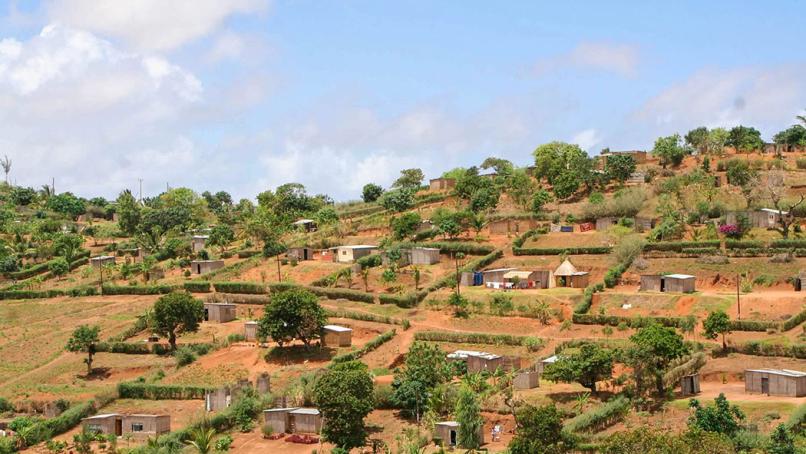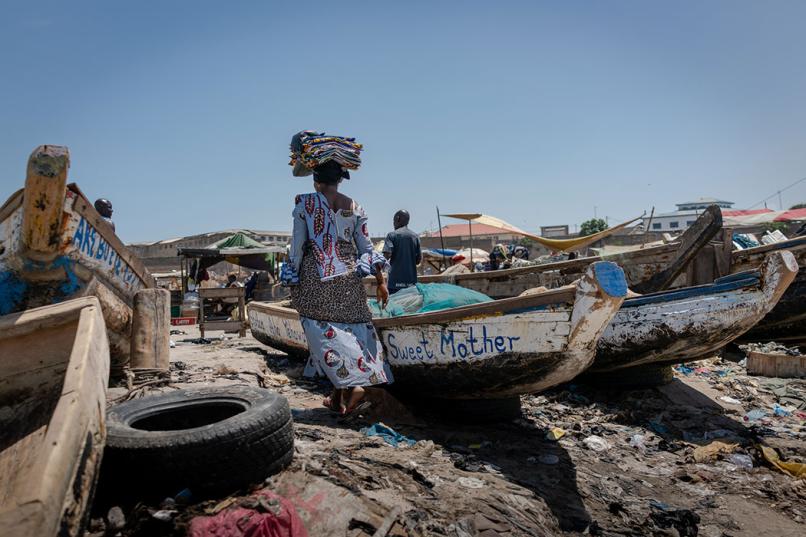New data: Cooling access gaps among women and men in 2022
 |
Contents See also: |
- Initial findings suggest that 719 million women and 448 million men worldwide are at high risk of lacking access to cooling services [1].
- The intersection of factors like poverty, high warming levels, gender norms [2] and a lack of basic rights and basic services, has a disproportionately negative effect on women and girls, hindering their ability to adapt and thrive in an increasingly warming world.
- A persistent lack of sex-disaggregated data poses serious difficulties to quantify cooling needs, guide gender-informed policies and solutions, and mobilize gender-sensitive finance.
Mainstreaming gender in access to sustainable cooling
The figure above provides an illustrative, not exhaustive, overview of how gender-specific factors can increase the risks related to heat and a lack of access to cooling. These are further unpacked in the following section Gender-based factors in access to cooling. Efforts to mainstream gender in the assessment of cooling needs and the design of sustainable cooling solutions require in-depth and context-specific analysis.
However, persistent gaps in sex-disaggregated data collection have hindered the development of comprehensive gender-informed policies for equitable access to cooling. Recognizing that women and men have different cooling needs rooted in their different roles and responsibilities in society, there is an urgent need to gather data to address these needs and mainstream gender in cooling solutions, policies and programmes.
Chilling Prospects 2023 will further examine approaches to mainstream gender implications in the global tracking of populations at risk of lacking access to cooling and make recommendations for sustainable cooling solutions for thermal comfort and safety, agriculture and food, and health services. Stay tuned!
Rural poor in focus Case study: Access to agricultural cold chains for women in Mozambique Access to cooling in rural areas is limited by the availability of basic infrastructure, services and supply chains; rural livelihoods are more vulnerable to climate change, and the effects of climate change are likely not gender neutral. In several high-impact countries — including Angola, Burkina Faso, Chad, the Gambia, Guinea, India, Mali, Mozambique, Niger, Nigeria, Pakistan and Senegal — rural populations tend to be comprised of more women than men. [4] In Mozambique, a Critical 9 [5] country for access to sustainable cooling, approximately 53 percent of the total rural poor population of 13.5 million are women (7.2 million). In addition to facing risks related to heat stress, a lack of access to cooling for rural women at risk in Mozambique exacerbates existing social and economic development challenges related to health, equality and access to decent work. At the same time, there is evidence that access to sustainable cooling can support growth in the agricultural sector. Mozambique loses about 30 percent of its agricultural production in post-harvest transportation and due to household storage challenges, with a lack of access to cold chains contributing significantly. Meanwhile, two crops for which refrigeration can extend shelf life, cassava and tomatoes, account for 64 percent of the total agricultural GDP, [9] and investments in agricultural cooling are beginning to show business potential. For example, after investing in cold room technology to manage production growth, Ausmoz Farm Holdings, located in the Manica province of Mozambique, eliminated its on-site waste of avocados and litchis for export. For women to benefit from access to cooling in Mozambique’s agricultural sector and improve their livelihoods, they must be directly targeted for financing and business development support. Early results of the Agriculture and Natural Resources Landscape Management (SUSTENTA) project, which aims to integrate rural farmers into sustainable agricultural value chains, showed an increase of overall crop production from 14 to 16 million tonnes between 2020 and 2021. But the beneficiaries of a matching grant scheme provided by the project are predominantly men, with female smallholder farmers only accounting for between 13 and 14 percent of beneficiaries. Under the Mais Peixe mechanism, a similar matching grant for the fisheries sector, only 29 percent of recipients were women, and they typically received less funding than men. So, while access to sustainable cooling has a potentially large impact for productivity and jobs in Mozambique’s agricultural sector, targeted support is necessary to ensure that women benefit in the same way as men. [10] |
Urban poor in focus Case study: Cooling resources for poor women in Accra, Ghana In other high-impact countries such as Bangladesh, Namibia and Peru, urban populations are comprised of more women than men. [11] In 80 percent of countries surveyed by UN Women and UN-Habitat, there are disproportionately high numbers of women aged 15 to 49 in urban slums. For example, in Ghana there are almost 130 female slum dwellers in the 15 to 49 group for every 100 males, representing over 4.5 million poor urban women at high risk. Similar patterns were observed in Cameroon, Congo, Côte d’Ivoire, Liberia, Malawi, Nigeria and Togo. In Ghana’s capital city Accra, heat stress is expected to be exacerbated as temperatures rise, with the city predicted to see 31 to 50 days with temperatures above 35°C and 10 to 21 days above 40°C in 2050. [12] For women living in Accra’s poor urban settlements, increased heat stress and a lack of access to cooling have important implications both in the workplace and the home. Approximately 83 percent of working women living in Accra’s slum communities work in the informal sector, [13] for instance as street vendors, service traders and domestic workers. Ghana is expected to be among the top ten countries in Africa — and the most affected in West Africa — for work hours lost to heat stress under a 1.5°C global warming scenario, with an almost 350 percent increase in hours lost in 2030 compared to 1995. [14] For female slum dwelling workers in Ghana’s informal sector, the impacts of increasing heat stress and traditional gender roles combined with a lack of formal workplace protections point to increasing risks in the workplace, and an urgent need for affordable cooling. In the home, low-grade housing creates additional risks for women living in Accra’s slum communities. A recent survey of three such communities showed that 46 percent of women live in compound houses, where multiple families share the same facilities, compared to 29 percent of men. The homes in the survey were found to lack electricity connections and adequate ventilation. This implies that during a heatwave, the women in these communities would have less access to cooling and be more vulnerable to extreme heat than men. Perception of heat can also vary by gender and maternal status. The same study found that women over the age of 30 in Accra’s slum communities reported higher perceived exposure to heatwaves than men. [15] Ultimately, more data are needed to shed light on gender-based cooling risks in rapidly growing cities. In Accra, where data show that poor, urban women are overrepresented in informal workplaces, are more likely to live in housing less tolerant to heat, and can have less physiological tolerance for heat, interventions that target compound dwellings and support community cooling resources for mothers and workers would support enhanced gender equity. |
Next
Gender-based factorsNotes and references
[1] Across 54 high-impact countries analysed in the Chilling Prospects.
[2] Gender norms refer to accepted attributes and characteristics of male and female gendered identity at a particular point in time for a specific society or community. Gender norms are ideas about how men and women should be and act. Internalized early in life, gender norms can establish a life cycle of gender socialization and stereotyping. (See UNICEF Glossary of Terms and Concepts)
[3] High-impact countries are those expected to experience sustained high temperatures that also have significant populations living in extreme poverty and lacking electricity access. For a full list, see here.
[4] Harsh Realities: Marginalized Women in Cities of the Developing World. UN Women, 2020. Link
[5] Critical 9 refers to the top nine high-impact countries for access to cooling. They are: Bangladesh, Brazil, China, India, Indonesia, Mozambique, Nigeria, Pakistan and Sudan.
[6] USAID: Loan Portfolio Guarantee – Development Credit Authority. Link
[7] World Development Indicators, Employment in Agriculture, Female – Mozambique. Link
[8] USAID Mozambique Factsheet: Gender Equality and Female Empowerment. Link
[9] Mozambique Economic Update: Getting Agricultural Support Right, World Bank, June 2022. Link
[10] Mozambique Economic Update: Getting Agricultural Support Right, World Bank, June 2022. Link
[11] Harsh Realities: Marginalized Women in Cities of the Developing World. UN Women, 2020. Link
[12] Health and Climate Change Urban Profile, Accra 2022. World Health Organization. Link
[13] Health and Climate Change Urban Profile, Accra 2022. World Health Organization. Link
[14] International Labour Organization (2019). Working on a warmer planet: The impact of heat stress on labour productivity and decent work. Link
[15] Owusu, Mensah, et al. “Gendered Perception and Vulnerability to Climate Change in Urban Slum Communities in Accra, Ghana. Regional Environmental Change, 19(3), January 2019. Link
